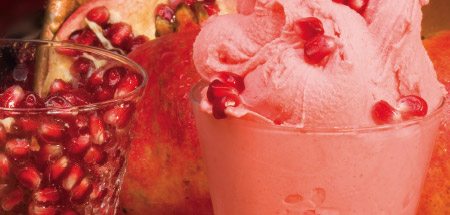
What is so super about the pomegranate – a superfruit that is turning up everywhere? A lot, but let’s start with the basics.
The name “pomegranate” derives from Latin origins, as a combination of pomum (apple) and granatus (seeded). Native to Middle Eastern regions, the pomegranate is now widely cultivated around the world and was first introduced to the western United States during the late 18th century. The fruit is characterized by a thick reddish skin and an off-white spongy interior membrane that surrounds approximately 600-800 arils – the small casings that encapsulate the seeds.

The arils are the sought-after portion of the pomegranate, and they can most easily be extracted by breaking open the fruit after scoring it with a knife, and then simply separating the arils from the membrane in a bowl of water – the arils will sink to the bottom while the white portions will float to the top. An appropriately ripe pomegranate will have a distinctive color, a fairly heavy weight to it and firm, taut skin with no visible splitting, which is generally an indication of overmaturation. The whole fruit has a long shelf life, similar to an apple, and is best if kept at refrigerated temperatures (32°F–41°F) with a moderate humidity level (80%–85%). The flavor of the pomegranate is generally considered to have a rather subtle, slightly acidic and mildly sweet flavor with notable tannic characteristics, but can vary based on factors such as ripeness and location of cultivation.
The pomegranate’s widespread attention and favor in recent years can be attributed not only to its taste, but also its discovered health benefits. While historically used to treat rheumatism and inflammation, the pomegranate has most recently been shown to contain substantial levels of antioxidants, phytochemicals and minerals, which serve to reduce the likelihood of cancer, heart disease, high systolic blood pressure and circulatory maladies. Additionally, pomegranate aril juice is a great source of Vitamins C and B, potassium, antimicrobial defenses, free-radical foraging tannins and antibacterial components to deter dental plaque. Furthermore, the results from a USDA study completed in November of 2007 suggest that the routine consumption of pomegranate juice may assist in deterring the damaging effects of habitual exposure to low-level radiation from cell phones, computers and other electrical devices.
Considering these health advantages, it is no wonder why pomegranate products have been applied in a broad range of industries. The juice can be consumed fresh, made into jellies and jams, used in frozen desserts and other pastry applications, or may be utilized in nonfood capacities such as natural fabric dye or a variety of cosmetic products. Interestingly, Grenadine – a popular cocktail ingredient – is made from pomegranate juice, desired for its flavor and brilliant color.
In light of significant customer and consumer demand, in addition to the flavorful and healthful aspects of this superfruit, PreGel AMERICA has recently introduced Pomegranate Fortefrutto® as one many exciting novelties for 2008. As with all PreGel products, this all-natural fruit paste is composed of the finest and freshest fruit available, and its unique flavor profile is sure to entice even the most discerning taste buds.
Sources:
California Rare Fruit Growers, www.crfg.org/pubs/ff/pomegranate.html
Wikipedia, http://en.wikipedia.org/wiki/Pomegranate
Pomegranate Health, www.pomegranatehealth.com/
